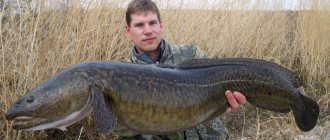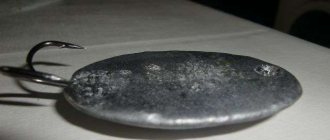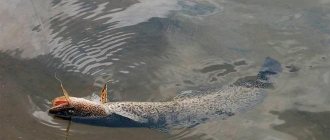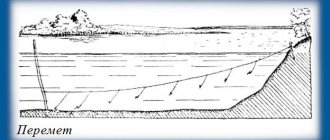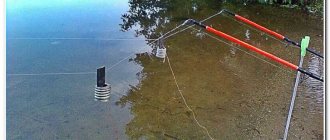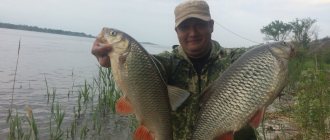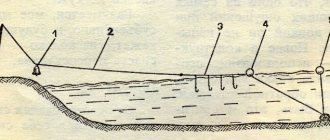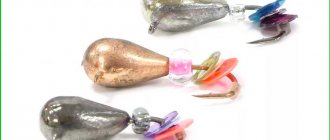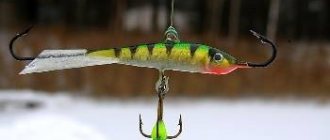Fishing time
The best time to catch burbot is when the water temperature is below 14 degrees. The predator prefers cold water and when it warms up, it swims to the bottom.
In winter, burbot spawn. At this time, the fish are not biting well, but you can catch several young individuals.
Therefore, it is recommended to fish in the fall. Autumn fishing for burbot on a donk is popular because individuals feed a lot, gorging themselves on fat for the winter. The predator is highly active at night. It does not rely on sight, but searches for prey by smell.
Watch a video about catching burbot in the fall using donka:
Features of catching burbot
Burbot lives on the bottom, therefore, it is necessary to choose areas of the bottom with vegetation and other kinds of obstacles. In autumn and winter, fish go to spawn, cold water is its element. It is before spawning that in the fall he comes across donk more often: zhor, and this affects everything.
The catching period is considered to be from mid-autumn to the third decade of spring. In summer, you can only catch burbot at night. High temperatures make the predator less active.
Photo: captured copy
Choosing a fishing spot
Burbot likes:
- Pits where the water is colder than usual.
- Near the snags.
- Near the stones.
- At the roots of the trees.
- Near the thickets.
Burbot moves in search of food, so there are no permanent habitats. It is impossible to determine the place where he lives. It can live both in deep and shallow water. Therefore, to search, you need to take several donks and throw them at different distances from the shore. This way you can determine the habitat of the fish.
Burbot does not swim in places with a soft or muddy bottom. It prefers rocky bottoms or places where there are a lot of tree roots. It is appropriate to start your search from the cliffs.
Burbot can also live in snags. But catching it there is risky, because if the fish resist, the line will break. You need to use bait to lure him out of these places.
Fishing is affected by the weather. In rainy, snowy and windy weather, burbot will bite well during the daytime.
It is appropriate to start fishing for burbot at about 6 pm. It bites well until about 8-10 am. After this, the bite gets worse.
Where did you catch burbot on a donk?
We collected reports from fishermen and found points on the map where they caught burbot on a donk.
Arrangement of burbot winter donkey
A winter donka for burbot is a fishing rod with a nod and the simplest equipment with a sinker and a hook. The tackle must be made durable; it turns out to be much more massive than a fishing rod for winter fishing for white fish. And this is natural - burbot is a large and strong fish with a huge mouth, the bait and, accordingly, the hook should be large.
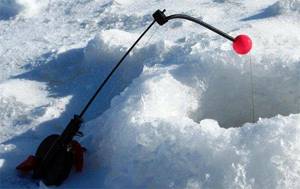
There are no special tricks for making a winter bottom - the main thing is that the sinker holds the bait at the bottom. For calm water, a regular olive will do; for fishing in the current, you will need a heavier load. The weight is put on the fishing line and is limited from below by a stopper. It is better to leave the leash as a continuation of the main fishing line, for the strength of the tackle. Hooks should be large, strong, with a long shank.
The simplest fishing rod for donkey is easy to make with your own hands - it’s just a stick (popularly a “swinger”) into which two nails are driven as a reel. The makhalka is equipped with a nod and spacers so that the burbot does not drag it under the ice when biting. Such gear is still used in the wild areas of Siberia. Any rough fishing rod with a reel and a nod that can be installed on the ice near the hole will do.
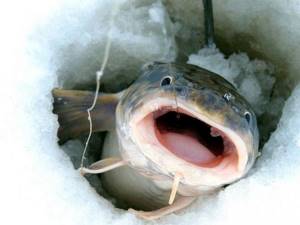
Any attachment used for catching burbot is suitable as bait:
- Zywiec
- Dead fish
- Sliced fish
- Tulka, capelin from the store
- Piece of liver
- Bunch of worms
- Shrimp
Burbot is not a shy fish. Therefore, to catch it, you can use a large set of rough gear. The main thing in such fishing is not the donk itself, but the search for this fish. It lives in strictly defined parking areas, leaving them for walks to hunt along the trails at night and to spawn once a year. It is useless to try to catch burbot by randomly moving around the reservoir - you need to find its specific habitats.
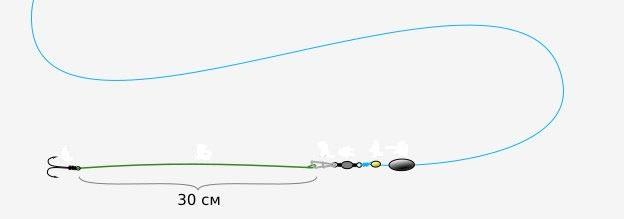
Sliding weight rig
Bite detection
When fishing with a winter donka, you need to worry about how exactly to determine the bite. In principle, an ordinary rough fishing rod with a spring guard will do. The peculiarities of burbot biting are such that the guard can twitch only once, when grabbed. And this means that the predator took the bait. After the fish grabs it, it doesn’t go anywhere, but stands in place for a long time, swallows its prey, and only then moves on.
At this moment, especially if the angler did not see the poke of the nod, the fishing rod may go into the hole. Therefore, it would be better to use some other solution - a crossbar with a hole, equipped with a nod and a homemade signaling device. In this case, the burbot will not be able to drag the tackle under water. Of course, if the angler is very vigilant about the bite, a regular rod with a rough nod will do.
It makes sense to use a winter donka for burbot if the angler has found (or knows) a permanent resting place (the trail of a semi-anadromous Siberian subspecies that rises to spawn). In this case, bites will be frequent, and you can count on a rich catch.

Rigging a winter donkey for burbot
How to catch burbot on a donk
In late autumn and early winter, it is necessary to install donks with a short distance. Leave for 50 minutes, check the bait. If some donks do not work after several casts, you need to check the design. You can also try swapping rods. You can also leave the donk overnight and check only in the morning.
If the water is not frozen, the fishing method is the same, but it is better to constantly stay near the fishing site to monitor the alarms.
If the bite begins in the form of a slight twitch, you need to smoothly lower the line. This is necessary so that the burbot does not feel resistance. Literally after 30 seconds, make a hook.
It is recommended to take several extra leashes with you - sometimes in the dark it is easier to replace it than to remove the burbot from the hook.
Features of choosing gear for catching burbot at different times of the year
The choice of gear for burbot also depends on the fishing season; the basic principles are given below:
- In winter, the most common gear is a girder; it is better to have several from 3 to 5 items that are placed on the shore.
- Spring and autumn are the most favorable periods for catching burbot; at this time of year its activity increases; You can use a donk or any gear for casting.
- In summer, the water warms up and conditions for burbot become not the most favorable, so fishing for it is low. You can only count on a catch in reservoirs where the water temperature does not rise above +10°C; When fishing, any suitable gear is used.
Lures
Burbot is a predator, so both bait and groundbait must be appropriate - meat. Fishermen use special devices to bait burbot. They make closed feeders with holes. There will be bait inside, for example maggot. Through these holes, the maggot will escape from the feeder into the water, attracting fish. It will take a long time for the maggot to get out, and the burbot will stay in this place.
Another option is to make a ball with soil and a bait of several worms inside. As soon as you throw the ball at the catch site, the soil will begin to be eroded by water, and the worms will gradually crawl out of it.
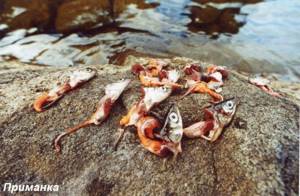
In addition, the following are suitable baits:
- Pieces of meat.
- Salo.
- Worms.
- Bloodworm.
- Maggot.
- Chicken giblets.
- Live frogs.
How to attach bait to a hook?
Bait bait is attached to burbot in two ways:
- Pierce the fish under the dorsal fin.
- Attach live bait to the lips.
Other methods will not work, since the fish will not be able to remain mobile and attract burbot. Small fish can also be cut into pieces. They will also attract a predator.
Read: How to properly mount live bait
When is the best time to catch burbot?
Understanding what time of year is best to catch burbot will allow you to fish with maximum efficiency and pleasure. Without proper knowledge, the catch will depend on luck.
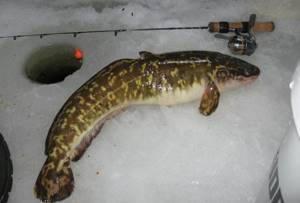
From the last ten days of September the fish begin to become more active
Features of choosing the time of year:
- autumn is the time of stable burbot bites. The fish begin to become active in the last ten days of September, after the water begins to cool steadily. Mostly caught in the fall with a donk: a bait or a feeder. What time of day to catch burbot? Definitely at night, now it is most active and can be caught well with live bait and large worms. The pre-spawning feast begins in late autumn. November promises to be successful fishing;
- In winter, active feeding of fish continues, sometimes the activity of the predator only intensifies. In December, you have to fish from the ice, and girders become popular. Live baits, baits made from pieces of meat and vertical spoons do their job quite well. Burbot spawning begins in January; this is a quiet period for fishermen; prey is caught on a hook relatively rarely. Since catching burbot after spawning is problematic, and the bite is unstable, it is better to use baits;
- in the spring the bite continues to deteriorate as the water warms up. The higher the ambient temperature, the greater the passivity of the fish. Catching a predator is still possible, but the results depend on the right location and gear. In spring, the chances of catching a large specimen are high, especially in March from the ice. As April approaches, the bite subsides;
- Summer is the most difficult period for a fisherman interested in hunting burbot. Only the most successful summer bait is capable of luring prey out of the hole. Typically, anglers avoid hunting cod fish in the summer. More often, burbot is caught only as bycatch in catfish fishing. In the summer, it makes sense to use a donk with a rubber shock absorber, a throw and a net.
We do not recommend going fishing in January and early February, as this is the period when you cannot catch burbot due to spawning.
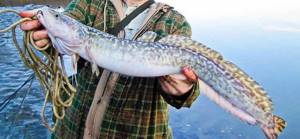
In inclement weather the predator bites better
Another important point concerns what weather is best to catch burbot. The cod predator bites better in inclement weather. The reason is not known for certain, but as the weather worsens, by human standards, the performance of burbot fishing improves. Prey is often hooked in the fall on cold nights with wind and rain.
Installation and equipment of the donkey
Installation method with one leash
To install the equipment for burbot you will need:
- Long rod;
- Fishing line;
- Coil;
- Sinkers;
- Hooks.
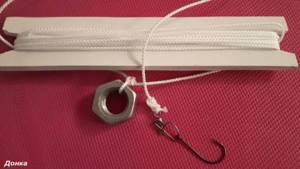
Install as follows:
- We wind the fishing line onto the reel. Its diameter is about 0.4 mm. This diameter is needed so that the fishing line can withstand strong resistance. It is desirable that its length exceeds 40 m. The color of the fishing line can be any, since fishing occurs at night.
- We attach a sinker to the tip of the fishing line. Its weight will depend on the current, but not lower than 45 g. The shape of the sinker should be round or oval so as not to overlap with the fishing line. In addition, this shape will allow the bait to lie on the bottom and not move during the current. If it moves, it may scare away the burbot. It is necessary that the load be sliding; it must be properly secured with the help of stoppers.
- You need to attach a leash. Its diameter is about 0.25 mm. The length is about 25 cm. There is a fastening method called a carabiner. It provides for a quick change of leash if it is not possible to remove the fish from the hook.
- Hook attachment. It should be large, thin and sharp. Suitable hooks size 7-12. It is important that there is a long fore-end. The thinner the hook, the less the fish is injured when pulled out of the water.
Installation of equipment with two leads
The design of the device is identical to the previous one. But here you need to attach one leash to the sinker, and the second one a little higher. The distance between them should be greater than the length of these leashes. Otherwise they may get confused.
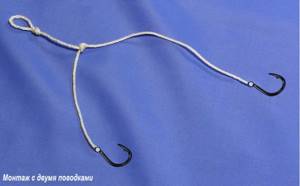
The design of a fishing rod for burbot with two leashes is not so convenient - the burbot can get caught on two hooks at once, and it becomes more difficult to pull it out of the water. There is a possibility that the bait on the second leader will not be on the bottom.
The most effective donks
There are a lot of such gear. However, not everyone shows good results when catching burbot. Let's look at the best donks for this predator.
With hook
To make it yourself you will need:
- extended spinning rod with a reel for long-distance casting;
- a reel or an ordinary plastic bottle for fishing near the shore;
- main fishing line with a minimum cross-section of 0.3 mm (the predator lives on a rocky bottom with snags, so it will easily get caught; if this equipment is thick, then you can safely pull it without fear that it will break);
- a sinker with a mass depending on the current and casting distance (it should not be carried away by the flow);
- leash made of monofilament fishing line with a cross-section of at least 0.25 mm;
- hook No. 8-12, depending on the size of the intended predator (there must be a long and thin shank so that it can be easily removed from the mouth after fishing).
How to make tackle correctly:
- Wind a fishing line no longer than 50 m onto the reel or reel (it is not provided for longer casting of the donk).
- Attach a sliding sinker to its end, limiting movements with stoppers.
- After about 40 cm, attach a swivel to the bottom or make a loop for a leash with a hook.
- Tie it with a figure eight.
If you plan to fish near the shore, then you can use a regular plastic bottle as equipment instead of a reel:
- Use a thin drill to make a hole in the lid.
- Thread the fishing line into it and secure it with a stopper so that it does not fly out.
- Wind the line in the middle. Many bottles have a recess there, which will be more convenient.
- Right at the fishing spot, unwind the required length of fishing line, make a loop at the end and place it under the wound elastic band for money.
- Make a cast, after which the bottle will stand upside down.
- When the fish takes the hook, the loop will come out from under the elastic. The bottle will become a kind of bite alarm: it will turn upside down.
- The most important thing is not to forget to tie a rope to the bottle and secure it on the shore.
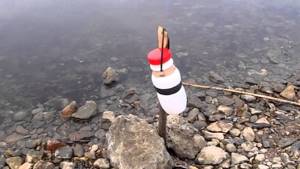
Rice. 1. Donka for burbot from a kefir bottle.
With two leashes
How to make such a donka with your own hands:
- Repeat all the steps (as in the previous manufacturing method), only add not one, but two leashes with a hook.
- They should be approximately 50-60 cm apart from each other. If it is less, the leashes will begin to constantly get tangled with each other.
Expert opinion
Valery Andreevich Sizov
Professional fisherman with 35 years of experience
Note! Experienced fishermen rarely use this type of donkey. They believe that the catch is not getting any better. In addition, even if the leashes are properly fixed, there is a risk of them getting tangled or caught on snags at the bottom. A single line will be easier to release than a double line.
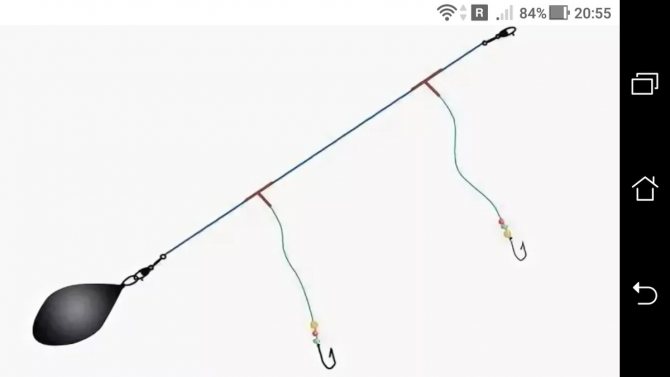
Rice. 2 Donka with two leashes.
Winter donka
An excellent option for winter fishing for burbot is the winter donka. Other types of this gear may be lost because In cold weather, the holes quickly become covered with ice and are covered with snow. This will not happen with a winter donka (zherlitsa). How to make it yourself:
- Use plywood about 1 cm thick and 20-25 cm long as a platform.
- Make slits toward the center with a drilled hole 1.5 cm from the middle.
- Insert a polypropylene pipe with a diameter of about 25 mm and a length of 20 cm into this hole.
- Attach a medium-sized inertial coil to it.
- Place a spring of approximately 20 cm at the top of the pipe. Attach a red flag to its free end. This will be a bite alarm.
- The spring should bend in the shape of an arc and rest freely on the reel with wound fishing line.
- When the burbot bites, the flag will rise, so the fisherman will know about the bite.
Expert opinion
Valery Andreevich Sizov
Professional fisherman with 35 years of experience
For reference! The plate is installed on top of the hole, so it does not freeze or become covered with snow.
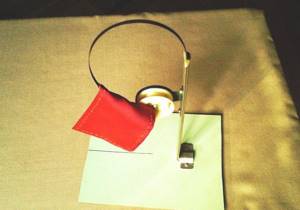
Rice. 3. Homemade donka on a plywood plate.
Fishing with winter donka
Instead of a spinning rod, a reel will be used, since winter fishing involves fishing not from the shore, but on the ice. You need to wind a fishing line on the reel, the length of which is 4 meters greater than the depth of the pit.
For each donk, you need to take a soft wire and tie a fishing line to it. Lower the wire into the hole. The hole will constantly freeze, so you will have to use an ice pick to break through it again. In such cases, there is a risk that the line will break. And the wire reduces this risk to a minimum. The 50-gram sinker must be attached so that it does not fall off in cold water. In winter there is no need to use bite alarms. You just need to constantly check the donk.
Donka is a very effective method of catching burbot. There are many varieties of bottom fishing rods. Through experience, the fisherman will choose the method that suits him.
Place of winter donka among other gear
Catching burbot in winter on a donk is not the most popular type of fishing, but this does not mean that it is ineffective. This method of fishing is not for everyone. Mostly anglers use knock fishing. For this, special knocker baits are used, as well as winter spinners and heavy burbot jigs. A passive fishing method is also often used - using winter burbot baits, hooks and pokes. Donk fishing is something between these two methods.
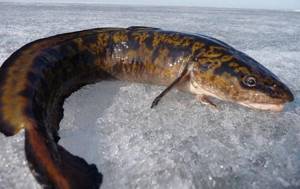
For winter donka fishing, equipment is used that is almost identical to the jig and a fishing rod with a nod, but the equipment is not left unattended, but is constantly under the supervision of the fisherman. This method is suitable for those fishing enthusiasts who want to fish with fishing rods and not with fishing rods. In this case, the tackle always stands at the hole, and not in the hand (as when fishing by knock). The fishing rod is installed in the hole, and the angler sits quietly and contemplates the nod, waiting for a bite. If you’re really bored, we take the donkey in our hands and catch it by knocking.
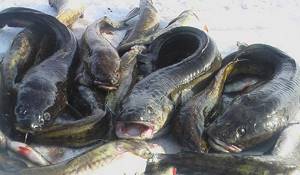
Catching burbot using a stick from the ice
For the cold season, burbot fishing enthusiasts came up with the so-called snitch. Already from the name one can assume that it works by hitting the bottom. That’s right, the fisherman actively “knocks” the artificial bait on the bottom, which provokes the burbot to bite. You have to make the spinners yourself, since they are not yet sold in fishing stores (with the exception of noise spinners, which can also be used). Homemade devices are very different in appearance.

Some look like a balancer, others look like a huge jig, there are models in the shape of a cylinder, cone, spoon... in general, anything, it’s not so important. The main thing is that the bait knocks and attracts the object of fishing, and for this you need a certain mass. Inventive fishermen even manage to attach a couple of metal plates to it, creating even more noise. And up to 5 hooks (single, double or triple) are soldered into the snitch.
The technique for catching burbot using a hook is simple. After measuring the depth under the hole, dead fish or fish meat are placed on the hooks, the bait is lowered to the bottom and they begin to tap rhythmically: raising and lowering the rod with an amplitude of up to 15 cm. The approximate number of beats per minute is about 30. After a bite, do not rush to hook. An interested burbot will not go anywhere, so let him first tighten the line properly. It should remain this way even when fishing; if it is weakened, the fish will jerk to the side and try to break the tackle.
Not everyone can catch burbot using a snitch. This kind of fishing will require a lot of patience, endurance, strong hands and, of course, warm clothes.
Changeover
Once upon a time this non-sports equipment was quite common, but today it has been undeservedly forgotten. The advantage of the line is that you don’t have to sit over it and wait for a bite in order to hook it in time. He literally catches himself. There are several varieties of this device, but only the bottom version is suitable for catching burbot. This is a thin twine, cord or thick fishing line (from 0.7 mm in diameter), on which leashes with hooks are located at a certain distance from one another. The optimal distance is considered to be 1 meter. Their number depends on the “appetite” of the fisherman. With the most modest approach, 10 or 15, but there are also real garlands of 50, 70 and even 100 pieces. Of course, such tackle will “cover” a large area, but even half a day will not be enough to bait it.
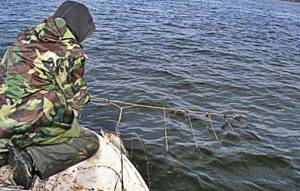
The fishing line is stretched between two stakes so that the hooks are at the bottom. Most often, the line is set at night and checked in the morning. The only disadvantage of this gear is that you will need a boat to fish with it. The baits used are the same as in donkey fishing.
Catching burbot using a line is a very interesting activity. When checking your tackle, you never know what you will pick up from the water: empty hooks or a huge fish that you have long dreamed of.
Fishing technique and tactics
It is important to take into account a number of nuances regarding fishing tactics, since learning to catch burbot correctly is an entire art. One of the most important aspects is the correct selection of bait.
How to catch burbot on the river:
- Catching burbot in the fall with a bait is effective both as a passive and active tackle. You can install the bait and remove it only in the morning or constantly monitor the fishing process using a light and sound alarm;
- In winter, it is better to use the tactic of tapping the bottom. We lower the spoon to the bottom, after a few seconds of waiting, smoothly raise the bait by 20-40 cm and carefully lower it back. Complicating the movements can scare away the fish; the only useful movement may be oscillating the rod in different directions with a small amplitude;
- in the warm season, the fish takes the bait into its mouth so softly that the only criterion determining the presence of a catch is the feeling of heaviness;
- In summer, the only successful tactic is to make precise casts to the predator’s habitats, close to the burrows.
Read more
What is fly fishing gear and how can a beginner assemble it?
Tips and tricks for fishing for burbot
The mistake of many inexperienced fishermen who begin to catch burbot fish is the desire to take the predator by the body. The fish is too slippery, like tench, it will easily slip out of your hands.
A few tips for catching a predator:
- It is important to correctly understand how to catch burbot using girders. The installation tactics are as follows: we make a hole 30x30 cm, a little higher we make another hole into which we insert a stick. We install the thread and a 100 g sinker, pull the fishing line to the bottom hole. Gradually the stick will freeze, and while checking the tackle we break it and remove the fish;
- Since catching burbot with a fishing rod is only possible in the fall, the key to fishing success is the correct choice of place. It is better to take a long fishing rod and go to places with steep banks and great depth. A good signal for the appearance of fish is the presence of a school of ruff;
- I often get questions about what depth to catch burbot. Everything is simple here - the minimum depth is 3 m, but usually fish are found deeper. It lies especially deep in summer, and in winter it is in the depth range of 3-6 m;
- anglers claim that burbot is interested in light at night. To attract a predator, it makes sense to light a small fire on the shore.
There are many burbot hunters today, but not everyone can become successful. With proper and high-quality preparation, the likelihood of catching a predator and tasting excellent cod meat increases significantly.
Originally posted 2018-09-11 14:14:09.
